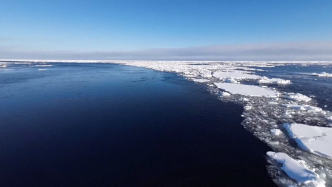

Satellite image of Antarctic iceberg A23a taken in November 2023. Image source: European Union
One of the largest icebergs on Earth is moving right now. The iceberg, called A23a, had been trapped on the Antarctic seabed for nearly 40 years. It has now drifted out of the northernmost tip of Antarctica and is melting in warm waters.
Satellite images provided by the British Antarctic Survey show that the iceberg is currently located at the northern end of the Antarctic Peninsula, stretching from West Antarctica to South America. Between 2022 and 2023, the iceberg moved thousands of kilometers across the Weddell Sea in the Southern Ocean, driven by ocean currents and winds. In late November, large amounts of ice arrived outside the Antarctic Peninsula.
Most icebergs from the Weddell Sea are eventually carried by ocean currents to "Iceberg Alley" in the South Atlantic, where they eventually melt.
The iceberg first calved off the Filchner-Roney Ice Shelf in West Antarctica in 1986 and immediately ran aground on the seafloor, where it remained for more than 30 years. In 2020, Andrew Fleming of the British Antarctic Survey noticed that the iceberg was starting to move. He said the iceberg eventually lost its grip and began to move.
Observations show that the iceberg is about 400 meters thick and covers an area of about 4,000 square kilometers, which is equivalent to more than four times the area of New York City in the United States.
While the iceberg is the largest currently floating in the world's oceans, it is not the largest ever recorded. The A-76 iceberg separated from West Antarctica in 2021 once reached an area of 4,320 square kilometers.
Chad Greene of NASA's Jet Propulsion Laboratory said that large icebergs like A23a break off the Antarctic ice shelf about once every 10 years, while the Filchner-Roney Ice Shelf occurs about once every 50 years. . "Icebergs are like earthquakes - there are lots of small icebergs and some big ones like A23."
Greene said it's not unusual for these giant icebergs to get stuck in place and stay that way, and they don't melt much in the near-freezing Antarctic waters. "An iceberg of this size can stay in one place for decades and then one day decide to leave."
The iceberg currently does not pose a threat to humans, but it could cause trouble for wild animals such as penguins or seals in the Southern Ocean if they become stranded on their feeding or breeding grounds.
Fleming noted that researchers see no clear link between the recent movement of icebergs and warming waters due to climate change. Greene said the iceberg was probably experiencing normal iceberg life cycle activity.
However, Greene also pointed out that it is clear that icebergs are breaking away from Antarctica faster than snowfall is adding mass to the ice, "which means that climate change is causing the Antarctic ice sheet to lose mass at a significant rate."
Researchers are alarmed by recent climate extremes in Antarctica, including record high temperatures and the loss of large areas of sea ice that help shield the continental ice shelves from warm waters and waves.
It is reported that after reaching a record low in 2022, the sea ice around the Antarctic continent has not recovered as much as usual this year, and is still well below average during the southern hemisphere winter. In September this year, the Antarctic sea ice area set a new record, more than 1 million square kilometers less than the historical record set in 1986.
(Original title "The world's largest iceberg is drifting away from Antarctica about 4,000 square kilometers and does not pose a threat to humans")


